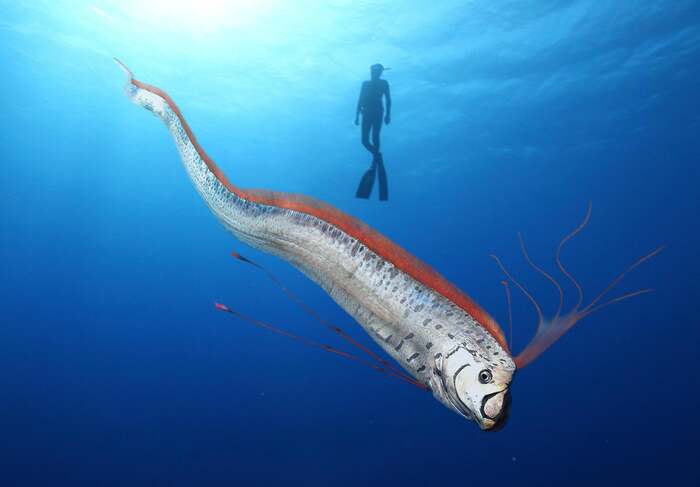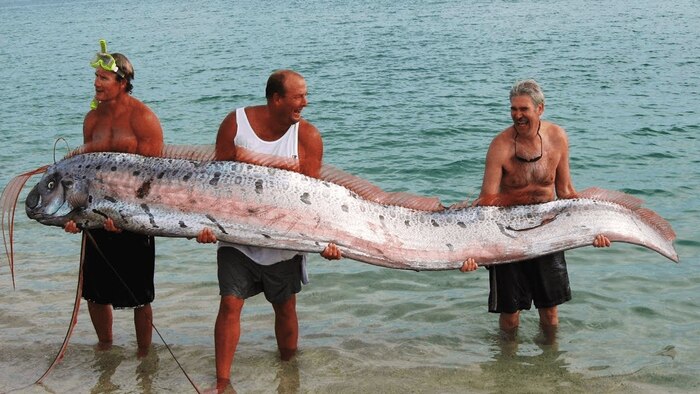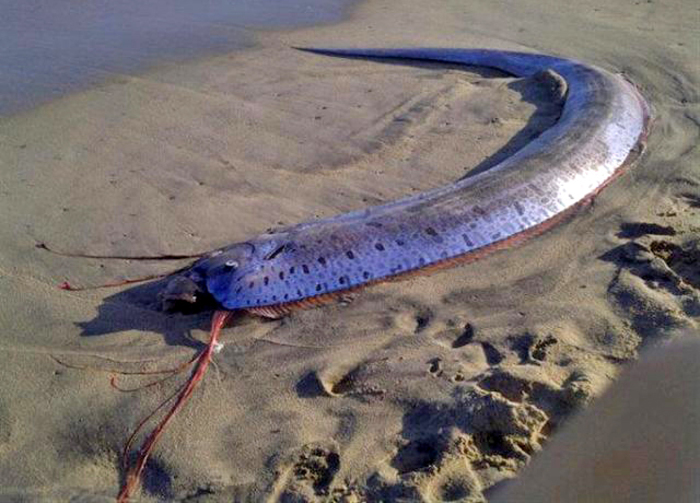Oarfish (Regalecus glesne), often considered a mysterious and enigmatic species, are among the longest fish in the ocean. These elusive creatures inhabit the deep waters of oceans worldwide, and their rare sightings have contributed to myths and legends about sea serpents. In this article, we will dive deep into the science of the Oarfish, exploring its physical characteristics, habitat, behavior, diet, migration patterns, and more. With this comprehensive guide, you'll gain a deeper understanding of the Oarfish and its significance in marine ecosystems.
The Oarfish (Regalecus glesne) belongs to the Regalecidae family, which is a group of fish species found primarily in deep ocean waters. Here is a simplified classification for the Oarfish:
| Taxonomic Rank | Scientific Classification |
|---|---|
| Kingdom | Animalia |
| Phylum | Chordata |
| Class | Actinopterygii |
| Order | Perciformes |
| Family | Regalecidae |
| Genus | Regalecus |
| Species | Regalecus glesne |
The Oarfish belongs to the Regalecidae family and is the longest bony fish species known to science. This species is widely distributed across tropical and temperate ocean waters but is rarely seen due to its deep-ocean habitat. The Oarfish has fascinated marine biologists and historians alike, as its appearance and behavior often inspire mythological stories and folklore, particularly in coastal communities where it is sometimes seen stranded on shores.
Scientific Name: Regalecus glesne
Common Name: Oarfish, Ribbonfish
Family: Regalecidae

The Oarfish (Regalecus glesne) is one of the most distinctive and fascinating fish in the ocean, easily recognizable due to its unique appearance. Here are the key features that define the appearance of the Oarfish:
Elongated Body: The Oarfish has an extremely long, ribbon-like body, often likened to a giant eel. Its body can grow up to 36 feet (11 meters), making it one of the longest bony fish in the world.
Slim and Flat: The body is narrow and flattened laterally, which contributes to its serpentine appearance. This body shape allows it to move with grace in the deep ocean.
Long and Wave-like: The Oarfish has a long dorsal fin that runs almost the entire length of its body. The fin appears like a wave or a crest, undulating with the fish’s movements in the water. This feature is a distinguishing characteristic of the species and contributes to its overall “ribbonfish” appearance.
Small, Forked Tail: The tail of the Oarfish is relatively small and forked, unlike many other fish with large, powerful tails. The tail helps the fish maneuver with subtlety in the deep waters it inhabits.
Anal Fins: These fins are found near the fish's tail and are much smaller in comparison to the dorsal fin, contributing to its streamlined appearance.
Small Head: The head of the Oarfish is small compared to the rest of the body, and it tapers toward the mouth.
Eyes: The eyes are relatively small and positioned near the top of the head. The eyes are adapted to the dark, deep-sea environment where light is minimal.
Silver and Shiny: The Oarfish has a silvery or metallic coloration, often reflecting light in a shimmering way. This is thought to help the fish blend with the shimmering surface of the ocean in its deep-water habitat.
Red to Pinkish Tail: The tail and fins may have a reddish hue or pinkish tint, which is a distinctive feature.
Long, Thread-like Barb: A prominent feature of the Oarfish is the long, thread-like structure that extends from the top of its head. This barb-like extension can sometimes be mistaken for a fishing lure or antenna.

Size: Can reach up to 36 feet (11 meters).
Shape: Ribbon-like, elongated, and narrow body.
Fin: Long dorsal fin running the length of its body.
Color: Silvery body with a pinkish or reddish tail.
Head: Small, with small eyes adapted for deep water.
Tail: Forked, small but effective for maneuvering in the deep ocean.
Length: Oarfish can reach lengths of up to 36 feet (11 meters), although most adults are much smaller, typically between 15-25 feet (4.5-7.5 meters).
Weight: Weighing up to 600 pounds (270 kilograms), Oarfish are massive creatures, making them one of the largest species of fish in terms of body length.
Body Shape: The fish's body is long and compressed, with a dorsal fin that runs the entire length of its body, creating an impressive, sail-like feature.
Coloration: They are generally silvery-blue with a red or orange crest on top of their heads.
The Oarfish's long, ribbon-like body and unique fin structure make it one of the most striking and enigmatic creatures of the deep ocean. Its serpentine appearance and silvery skin contribute to its mystical reputation, with sightings often linked to maritime myths and legends.
Oarfish are believed to live for 15 to 20 years, but much of their life history remains a mystery due to their elusive nature.
Oarfish are deep-sea dwellers that live at depths ranging from 200 to 1,000 meters below the surface. These fish are found in both the Atlantic and Pacific Oceans, inhabiting temperate and tropical waters. They are often seen in open-ocean environments far from shore, making their sightings rare and difficult to document.
Distribution: Oarfish are found globally, with sightings occurring off the coasts of California, Japan, Australia, and other parts of the world.
Habitat: These fish tend to be found in deep, offshore waters, although they are occasionally observed near the surface, especially when they are ill, injured, or dying.
The Oarfish is a solitary creature, and due to its deep-water habitat, it remains largely undisturbed by human activity. Observing their natural behavior is difficult, but occasional strandings provide valuable insight.
Swimming Behavior: The Oarfish uses its long, ribbon-like body to undulate through the water, often using its tail for propulsion and its dorsal fin to stabilize its movement. Its pelvic fins are small and rudimentary, contributing less to its locomotion.
Elusive Nature: Oarfish are rarely seen near the surface unless they are injured, sick, or dying, which is when they often wash up on beaches. These rare encounters often lead to sightings of giant, serpentine creatures in folklore.
The exact migration patterns of Oarfish are still poorly understood. However, they are known to travel long distances in deep water and often shift to different depths depending on seasonal and environmental changes. Given their vast range across tropical and temperate oceans, Oarfish may migrate to different parts of the world in response to changes in temperature, food availability, or breeding conditions.
Deep-Ocean Migration: Oarfish are believed to be seasonal migrators, moving between deeper and shallower waters depending on ocean currents and the time of year.
Movement Patterns: Their behavior also suggests that they follow the currents and seek out specific depths that suit their feeding habits and the cooler waters they thrive in.
The Oarfish is an opportunistic predator, meaning it feeds on whatever is available in its environment. Their diet primarily consists of small plankton, krill, and small fish. They use their long bodies to capture prey in the open ocean by filtering through the water or snapping at smaller organisms that swim near them.
Diet: Oarfish primarily feed on zooplankton, krill, and small fish, though their diet may vary depending on their location and the availability of food.
Feeding Strategy: They are not aggressive hunters; instead, they feed on organisms that drift or swim near them, relying on their elongated bodies to intercept and capture prey as they move through the water.
Oarfish are oviparous, meaning they lay eggs that are fertilized externally. The reproductive behaviors of Oarfish remain largely unknown due to their deep-ocean habitat, but it is believed that they lay eggs in deep, offshore waters. Little is known about the exact reproductive cycle of the Oarfish, making it an area of active research for marine biologists.
Currently, there is only one recognized species of Oarfish, which is the Regalecus glesne. However, within the family Regalecidae, other related species exist, though none are as well-known or as widely studied as the Oarfish. Here's a summary of the known species in the Regalecidae family:
| Species Name | Common Name | Key Characteristics |
|---|---|---|
| Regalecus glesne | Oarfish | Longest bony fish, up to 36 feet, elongated body, found in deep waters. |
| Regalecus russelii | Ribbonfish | Similar to Oarfish but slightly smaller; found in tropical and subtropical oceans. |
| Regalecus reighardi | Pacific Oarfish | Not as widely studied, inhabits Pacific deep ocean waters. |
The Oarfish is the most recognized member of the Regalecus genus, known for its giant size and distinctive appearance. Other species in the family Regalecidae are less commonly encountered and remain relatively obscure.
In summary, Regalecus glesne (Oarfish) is the standout species in its family, while other species, though related, tend to be less prominent in the scientific and public eye.
Oarfish are currently not considered endangered, but their population is difficult to assess due to their elusive nature and deep-sea habitat. As a species that rarely interacts with human activities, Oarfish are not directly threatened by overfishing, but they may be indirectly affected by environmental changes such as ocean pollution and climate change.
Conservation Status: The Oarfish is classified as Least Concern by the International Union for Conservation of Nature (IUCN).
Protection Measures: Due to their remote habitat, there are no specific conservation measures in place for Oarfish, but general marine conservation efforts aimed at protecting deep-sea ecosystems may indirectly benefit the species.
Oarfish play a critical role in the deep-sea food web. As top predators in their environment, they help regulate the populations of smaller organisms such as plankton, krill, and small fish. By maintaining balance in the ecosystem, Oarfish contribute to the health and diversity of marine life at deep-sea levels.
Food Chain Role: Oarfish are an important part of the food web as they help control populations of smaller fish and zooplankton.
Ecological Importance: Their presence in the ecosystem indicates a healthy, functioning deep-sea environment.
Oarfish have long been a part of local myths and legends in coastal communities. Their serpentine appearance and rare sightings have led to stories of sea monsters and giant sea serpents in cultures from Japan to the United States. In some cultures, the sighting of a dead Oarfish was believed to predict earthquakes or tsunamis, adding to their mystique.
Mythology: Oarfish are often associated with myths of sea serpents, with their long, ribbon-like bodies contributing to the folklore of sea creatures in various cultures.
Superstitions: In Japan, the Oarfish is sometimes considered an omen of upcoming seismic activity.The oarfish has been nicknamed the "doomsday fish" because, historically, appearances of the fish were linked with subsequent natural disasters, namely earthquakes or tsunamis.
While Oarfish are not a target of commercial fisheries, their rarity and unique appearance make them a valuable subject for marine tourism and scientific research. Their deep-sea habitat means they are rarely encountered, which only adds to their allure for oceanic researchers and those fascinated by the mysteries of the deep sea.
Tourism and Research: The Oarfish is of interest to both scientists and marine tourists who seek to learn more about deep-sea life.
Scientific Importance: As one of the largest and longest fish species, Oarfish provide important insights into deep-sea ecosystems and marine biology.
Oarfish are not commonly caught by commercial fisheries due to their deep-sea habitat and elusive nature.their flesh is not well regarded for eating due to its gelatinous consistency. However, their occasional stranding on beaches can sometimes lead to their capture. Their deep-water habitat generally keeps them out of range for most fishing operations, and they do not contribute significantly to global fish catch totals.

The Oarfish is one of the most fascinating and mysterious creatures of the ocean. Its immense size, unique physical characteristics, and elusive behavior have made it a subject of scientific curiosity, folklore, and marine mythology. As researchers continue to uncover more about this giant fish, we can only speculate on the many mysteries that still surround its life cycle and behaviors. The Oarfish’s role in the deep-sea ecosystem is vital, and understanding its place in the marine world helps us better protect these incredible creatures and the ecosystems they inhabit.
animal tags: Regalecidae
We created this article in conjunction with AI technology, then made sure it was fact-checked and edited by a Animals Top editor.